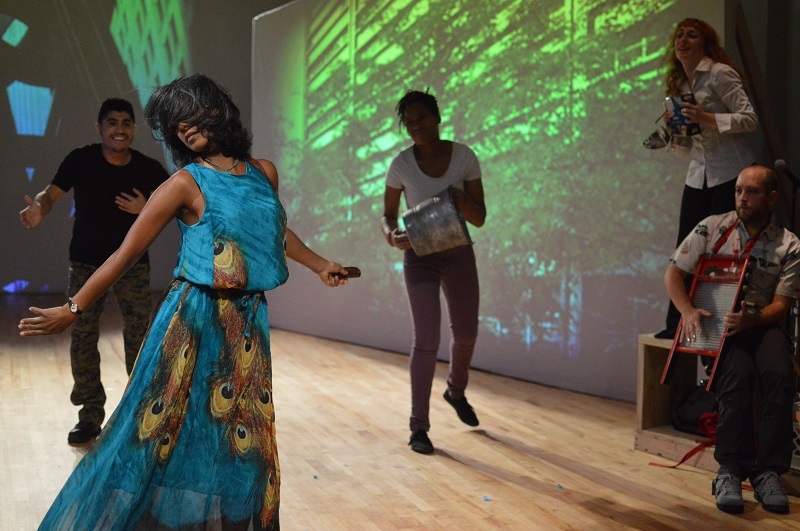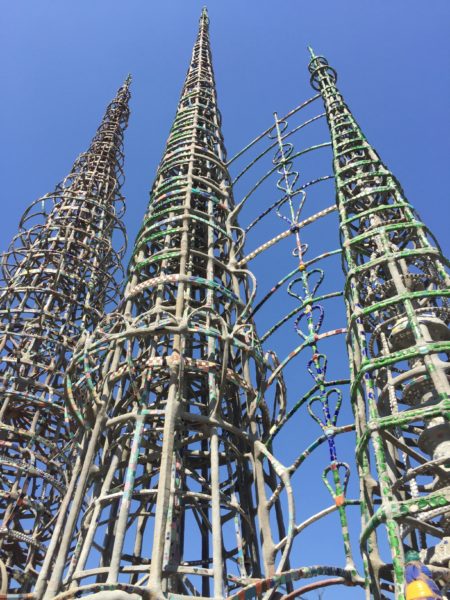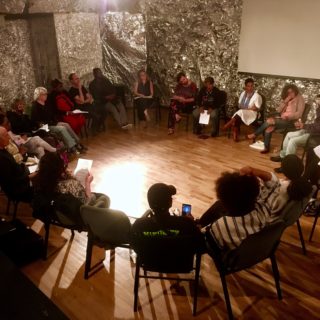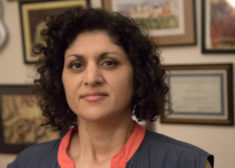As a young kid with two college-educated immigrant parents, I bought into the model minority myth, hard. I implicitly understood that I had to work the hardest, be the best, ace the tests, read the most books, play a musical instrument (or two), have the most extra-curricular activities – basically succeed by every metric put in front of me, and then I could feel good about myself. My sense of achievement was directly tied into my sense of self-worth. And it worked. I played the game, and I was pretty good at it. I liked competing with other kids in my classes because I liked landing at or near the top. Was it to justify my being there? To allow myself to ignore all the comments (as a young kid) about why I talked with a funny accent? (I learned English from my Indian mother and my Cypriot father, so despite being born here, I sounded like an immigrant when I got to public school). To allow myself to ignore all the comments (as a teenager and young adult) about how exotic I looked and answering the question of “what are you” wherever I went? Who knows. I never “fit in” throughout my childhood in the predominantly white San Diego suburbs, but at least with the model minority myth I could “fit above.” At least that’s how I saw it until much later on.
I have also always believed deeply in fairness and, by extension, in the importance of justice. I guess it was my relative privilege growing up that allowed me to buy into the existence of these concepts so wholeheartedly. In my late teens, as I began to understand structural inequality and its resounding effects on people’s lives, I became drawn to things I could participate in to attempt to correct for these structural inequalities which, I had come to understand, were making the world so unfair.
Simultaneously, I was falling in love with the performing arts - an incredibly unfair line of work! From the casting process that implicitly privileges white standards of beauty and absurdly expensive training programs, to the proliferation of unpaid internships taking the place of junior level staff positions in nonprofit performing arts organizations, to unconscious biases against women and people of color in technical positions, this world I have grown to love so much is rife with structural injustices – and it was going to take more than fulfilling my model minority status to begin to tackle these issues.
It took me years to begin to understand the flipside of buying into the model minority myth, but even as I’ve started unpacking this for myself, I catch myself slipping into old habits and thought patterns. I still beat myself up pretty badly about the smallest mistakes. I still feel the need to constantly justify my “usefulness” and “value” at work by staying late, obsessing over details, and always checking myself to be sure I’m being the best “team player” I can be – which in my mind means the team player who works the hardest. And I should mention that this is in a quite positive and functional work environment!
From the start of my career in the performing arts, and specifically theatre, I’ve had the good fortune to have mentors who were people of color. The first theatre company I worked with on a long-term basis was based in Watts (Watts Village Theatre Company) and had been led by Black and Latinx folks for its entire history. Working with this small nonprofit in this community quickly opened my eyes to the vast injustices that I had had the good fortune to not fall prey to as I grew up – and got me focused on doing all I could to lift up the work of this Black and Brown-led company.
It should also be noted that this company’s Black and Latinx leadership (especially the artistic and managing directors at the time: Guillermo Aviles-Rodriguez and Damian Teeko Parran) quickly welcomed me with open arms, recognized that I had a capacity for leadership, and gave me my first job as a theatre producer, a path I have now continued on for 13 years. That is to say, my work with this company was not out of a sense of charitable obligation on my part (the model minority “helping the underserved” Black and Brown community), but out of mutual learning and artistic affinity. Looking back, it feels bittersweet that this start to my career in the arts, this cross-racial and cross-cultural solidarity, seems to be the exception rather than the rule.
Soon after moving to New York to further pursue theatre, I found myself hungry for the type of cross-cultural affinity I experienced working with Watts Village. I also began to find my way into the world of Off Broadway theatre and its deeply entrenched structural biases and gained a newfound appreciation for the fact that I had been recognized as a leader and given so much agency early in my career, especially as a young woman of color. I seriously doubt I would have pursued a similar path, and likely would have left the field entirely, if it hadn’t been for this early positive example of what was possible in the world of theatre-making. This inspired my partner and I to create our own company in 2011, called Radical Evolution, which has since come to focus on the complexity of the mixed identity experience. As theatre makers who both identify as bicultural, we assemble people from a variety of cultural backgrounds to explore the cultural complexity of what it means to be “American” in the context of the 21st century, and to highlight the experiences of folks who identify as more than one race/ethnicity – the fastest growing demographic in the US.[1]

Last year, in the midst of the trashcan fire that was the early days of the Trump administration, I was excited and inspired by the Reparations365 series at JACK. While I was connected with a few different groups organized around undoing structural racism in the arts and culture sector, I was intrigued by the potential intersection of a conversation around the economic aspects of systemic racism housed in an arts and community space. Furthermore, I had understood the idea of reparations to be an inherently radical idea – something that folks fighting for incremental change couldn’t even quite wrap their heads around. Just as I’m excited by and drawn to seemingly impossible artistic ideas, I was drawn to the idea of reparations – consistently dismissed by politicians, anathema to conservatives, perceived as too complicated and out of our collective reach for liberals. Just my cup of tea.
At the first community conversation I attended at JACK, I was the only person of color who did not outwardly identify as Black. There were also a good amount of white folks there, and some spoke candidly and passionately about their want to discuss reparations. And, as so often happens in so many situations, a binary was established. White and Black. Oppressor and oppressed. As has happened countless times in my life, I found myself in the uncomfortable space in between, wondering if others were wondering why I was even there to begin with.
Luckily, the conversation was engaging and rigorous, and I left inspired to think further about my own history and its relationship to systemic inequities. That’s when I started questioning how my family, even as 20th century immigrants to this country, may have benefited from social structures that were set up long before we arrived. The notion of reparations as something that I didn’t need to worry about or participate in because I did not fit directly into this binary didn’t feel right to me, but I was struggling to understand my place in the conversation. I’m excited and grateful that this spurred me to look into South Asian and Black solidarity movements, and South Asian scholars and activists who are working against anti-Black racism from their own personal perspective. I also began to scratch the surface of the historical underpinnings of the role of South Asians (and most Asians, once they come to this country), as the model minority, and the ways in which this stereotype has upheld and continues to uphold structures of white supremacy.
The 1965 Hart-Celler Act removed overtly racist immigration quotas shortly after the 1964 Civil Rights Act was passed. While there were likely many strategic reasons for this act, including America’s military intervention in Southeast Asia at the time, politicians were able to link the two pieces of legislation to show the United States’ steady march toward equality. “We have removed all elements of second-class citizenship from our laws by the [1964] Civil Rights Act,” declared Vice President Hubert Humphrey. “We must in 1965 remove all elements in our immigration law which suggest there are second-class people.”[2]
While on its surface this law removed the previously harsh restrictions on immigration from Asian countries, it also put a cap on the number of immigrants from Mexico and Latin America that were allowed to enter the country each year, creating a structure that separated Brown communities from each other, and set Asian and Latinx immigrants down divergent paths.[3] This continues to this day, with the large number of South Asians who immigrate using H1B Visas, allowing themselves to be categorized as “skilled workers” and thereby separated from other, much less valued, immigrant labor.
South Asians are often overtly pitted against Black communities, and viewed in opposition to other Asian groups. This can happen without much awareness of who is making these distinctions, and without explicitly acknowledging the lens of capitalist productivity. In his 2001 book The Karma of Brown Folk, author and historian Vijay Prashad describes a visit that Bill Gates made to India in 1997. Gates announced on this trip that “South Asians are the second-smartest people on the planet.” He then goes on to rate the Chinese as the smartest. Prashad then notes that “white people, like Gates, do not get classified, since it is the white gaze, in this incarnation, that is transcendental and able to do the classifying!”[4]
Prashad then connects this commodification of immigrant labor directly to the white supremacist strategy of continuing to oppress African Americans in the post-Civil War era:
"Capital relishes immigrant workers from zones of exploitation, since many of them work for lower wages and their immigrant status renders them less able to be critical than enfranchised workers. The migrant workers can be controlled by the discipline of tenuousness: If you are feisty you are fired, and not just into the labor market to seek alternative employment but out of the country…The U.S. state adopted the policy of using foreign workers in its Contract Labor Law (1864), which legalized an earlier arrangement by which contractors went to Europe and Asia to recruit workers on what were virtually indenture contracts. In the 1860’s there was even a suggestion made to flood the U.S. South with South and East Asian workers to shift the blacks from the land and to undermine their power as newly freed peoples.[5]"
So how does the South Asian community participate in Reparations – particularly those of us who were born here and who enjoy the privileges of citizenship, middle class to upper middle class upbringing, and access to higher education? How can we be better co-conspirators with other Brown and Black communities?
Here are a few thoughts and ideas, inspired by some of the things I’ve read about South Asian and Black solidarity movements, and from various conversations in organizing spaces I’ve had the good fortune to become a part of. Shoutout to Artists Co-Creating Real Equity (ACRE), a multiracial cohort of artists and cultural workers undoing racism in the arts and culture sector, and the Asian affinity group, both of which are under the umbrella of the People’s Institute for Survival and Beyond (PISAB). The analysis offered by PISAB and the conversations I’ve had at these meetings have been instrumental to my path of learning.
A Working List of Strategies:
Interrupt anti-Black racism when it happens in your own circles. As the daughter of a Brown immigrant woman, one of the things I still have the hardest time with is disagreeing, arguing my point, and sticking to it when I know I’m right in principle. I want to get better at calling folks in, explaining my logic, and convincing people to see my point of view, especially when I’m trying to interrupt prejudiced beliefs that are harmful and dehumanizing to people I care about. Plus, by standing up for my ideals and refusing to be a quiet and compliant model minority, I am also disrupting widely held stereotypes about South Asians and immigrants in general.
Recognize your proximity to Whiteness – especially if you are lighter-skinned (more on colorism here) – and use that to leverage resources. As a very light skinned, bicultural South Asian woman, I read as ethnically ambiguous to most White folks, and also not that foreign or threatening. I want to use my access to the White world, specifically the world of the performing arts, where I do hold gatekeeper status, to open up space, leverage resources and create a platform for Black and Brown folks to tell their own stories on their own terms. And in an attempt to address the economic aspects of reparations, I want to be sure that these opportunities involve compensation and that I do what I can to interrupt the often dehumanizing structures that devalue artists, and particularly artists of color.
Highlight injustices in education, business and anywhere else. South Asians are perceived to be “succeeding” as the model minority community. Point out that if systems like public education and higher education aren’t working for all of us, then they aren’t working for any of us. We are expected to take what we’re given and shut up, but I want to make sure not to take advantage of systemic inequities that will privilege me over other Black and Brown communities and instead ask strategic questions about why these resources aren’t accessible to all. If I am getting something more because of my model minority status, then I have to be ready to give it up.
Lift up South Asian public and historical figures that have agitated for justice before us, and those who are doing it now, whether through politics, arts and media or public service. There are too many high profile examples of South Asian politicians (Bobby Jindal and Nikki Haley to name just a few), who unabashedly buy into the myth of White supremacy, and unsurprisingly, are rewarded for it by the political and media establishment, resulting in increased public visibility. Let’s highlight and put our resources behind the public figures, community leaders and artists who advocate for racial and social equity like US Congresswoman Pramila Jaypal, author and historian Vijay Prashad (quoted above!) and comedian and documentary filmmaker Hari Kondabolu.
Organize cross-cultural affinity spaces for those who work in the same field. This is built into the DNA of Radical Evolution as a company, but the basic principles of this can also be applied elsewhere and in organizing contexts. Radical Evolution builds affinities between artists of different cultural backgrounds (and often different artistic specializations) by bringing people together to work on an artistic project and collaborate toward the common goal of making a piece of performance together. What if we applied the same creative thinking and solidarity-building to organizing movements? What if we built something beautiful together that was more ongoing and ever-evolving than the ephemerality of a few days or weeks of performances? Lately, we have been inspired to re-focus Radical Evolution’s process around these more long-term ideas and strategies, in an effort to create relationships that resonate during the artistic process, but also radiate out into the world beyond. Process is product. Art is life. And the inverse. And so on and so forth as we struggle together to make a more just world to live in. What does a cross-cultural affinity space look like in your workplace, or even amongst others who work in your field? And to return again to the economic question of reparations, how can resources in your field be refocused and reallocated more equitably? The Reparations365 series at JACK showed a few inspiring examples of these efforts, including Wildseed Collective and reparations.me.
As I continue to dismantle the expectations of the model minority myth for myself, I’m beginning to formulate what my place could be in the conversation around reparations. I think it involves disrupting the easily established binary of Black/White in the conversation and highlighting positive examples of Black and South Asian solidarity. Then of course it is following those examples in my own actions. All these years later, I want to re-commit to my youthful belief in fairness and justice and struggle to bring reality closer to these ideals. I am also excited to build with other South Asians (and all Asian-identified folks) who have similar politics, to establish a collective and meaningful voice in the reparations conversation. Where y’all at? Hit me up!
Most of all, I want to use my artistic work to create proposals for what a more just world would look like, and act out my vision for that more just world whenever and wherever I hold space. I want to continue to forge cross-cultural connections in my art making and organizing, because as someone who identifies as bicultural, I need these spaces to exist as my full self. I firmly believe that out of these spaces will spring visions of new systems and new ways of being. And through these systems, we will discover that reparations is a project for us all.
[1] “Multiracial in America: Proud, Diverse and Growing in Numbers.” Pew Rsearch Center: Social and Demographic Trends. June 11, 2015. http://www.pewsocialtrends.org...
[2] “The Immigration Act That Inadvertently Changed America.” By Tom Gjelten. The Atlantic October 2, 2015 https://www.theatlantic.com/po...
[3] “The law that created illegal immigration.” By Jane Hong Los Angeles Times October 2, 2015 .http://www.latimes.com/opinion...
[4] Prashad, Vijay. The Karma of Brown Folk. Minneapolis: University of Minnesota Press, 2000. p. 70.
[5] Ibid. p. 71


